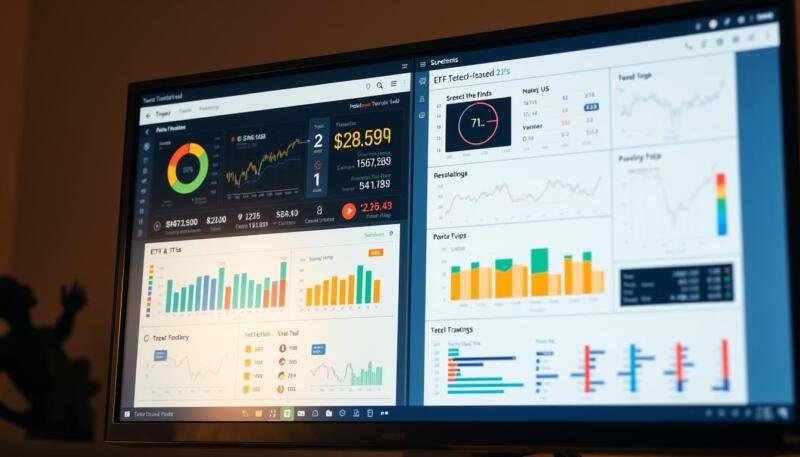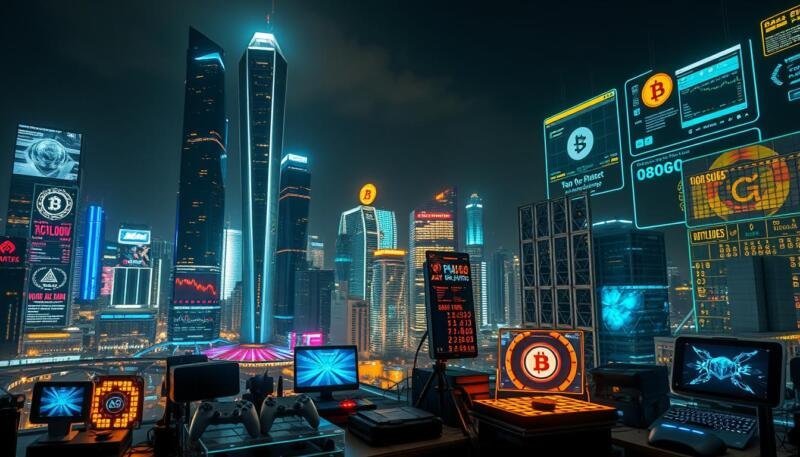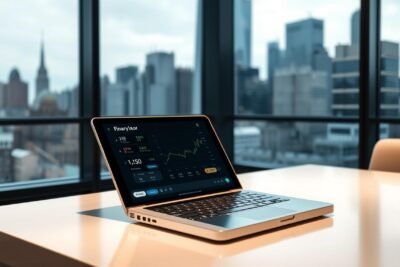
Australia Tech ETFs: Capitalize on Sector's Expansion

When you first watched a tiny startup become a household name, it felt like watching a rocket lift off. You remember the buzz, the quick price jumps and the stories about new services reshaping daily life.
That volatility matters. It shows why many australian investors now look beyond local markets for broader exposure. etfs let you access major companies and themes without picking a single share.
In this guide you'll get a clear roadmap to tap into technology via the ASX. We explain which funds lead the pack, how to compare fees, spreads and liquidity, and how to balance potential returns with real performance risk.
Think of this as a practical start: by the end you'll know which funds suit your goals and how to place a trade on the exchange with confidence.
- Why tech now: the market backdrop Aussie investors are trading into
- How we shortlisted the best tech ETFs for a Product Roundup
- Top broad technology ETFs on the ASX to consider for your portfolio
- Thematics riding momentum: from Aussie tech to crypto and gaming
- Australia tech sector ETFs growth: building a diversified portfolio with the right mix
- How to invest on the ASX: brokers, orders and execution for ETFs Australia
- Your next move: shortlist the right tech ETFs and position for future returns
Why tech now: the market backdrop Aussie investors are trading into
When market leadership sits offshore, your portfolio needs a wider lens. The local share market holds only about a 3% allocation to technology, while the U.S. sits near 27% that gap matters for your returns and exposure.
Global weight: why you may need broader exposure
For australian investors, a technology etf or a 100 etf can bridge the shortfall in domestic listings. Index trackers give you access to leading companies and reduce single-name concentration risk.
Volatility check: sharp moves matter
Markets move fast. A notable example: Nvidia fell roughly 17% in one day in early January 2025 on chip‑cost news tied to DeepSeek, then bounced back. That shows how performance and returns can swing around news.
How etfs offer diversified access
ETFs offer diversified exposure so you own a basket rather than guess winners. You can compare types from broad NDQ/HNDQ trackers to a concentrated global fang etf and pick what fits your risk profile.
- Check weightings, liquidity and valuation data before you add funds.
- Remember the s&p asx alone may not capture pure technology momentum.
- Use sensible orders when trading to control slippage during news-driven moves.
"Expect elevated volatility when breakthroughs or chip news hit the headlines."
| Fund type | Example | Focus | When to use |
|---|---|---|---|
| 100 etf | NDQ / HNDQ | Top non-financial NASDAQ names | Core global technology exposure |
| Concentrated | Global FANG ETF | Large-cap internet & AI leaders | High conviction, higher volatility |
| Local tracker | S&P ASX tech index | Homegrown companies | Complement, not replace, global funds |
Want examples of low‑risk U.S. index options for global exposure? See a curated list of the technology etf choices to compare fees and liquidity before trading.
How we shortlisted the best tech ETFs for a Product Roundup
Start with measurable yardsticks so you can compare funds on the same playing field. We used objective screening metrics and exposure design checks to build a tight shortlist you can trust.
Screening metrics focused on fund size (FUM), management fee, average buy/sell spread (slippage), trading liquidity on the exchange, live share volumes and multi‑year performance/return records.

Exposure design reviewed index methodology, regional and sector mix, and top‑holdings concentration to judge risk and upside. For example, FANG is highly concentrated (top‑10 = 100%), while TECH sits at 41.6%.
"Tight liquidity and low slippage can save more in costs than a small difference in fee over time."
- NDQ: largest (~$6.6b FUM) and most liquid (~$17m ADV); fee 0.48% / slippage 0.04%.
- FANG, HACK, ASIA and TECH were compared on FUM, ADV, fees and 5‑year returns to 30 June 2025.
| Fund | FUM | ADV | Fee / Slippage | 5yr return |
|---|---|---|---|---|
| NDQ | $6.6b | $17m | 0.48% / 0.04% | 19.1% p.a. |
| FANG | $1.2b+ | $7m | 0.35% / 0.07% | 30.8% p.a. |
| HACK | $1.4b | $2.8m | 0.67% / 0.12% | 19.2% p.a. |
| ASIA | $669m | $1.8m | 0.67% / 0.16% | 8.0% p.a. |
| TECH | $339m | $0.68m | 0.45% / 0.30% | 13.3% p.a. |
Want a deeper list of top-performing U.S. index options to compare fees and liquidity? See our curated choices here.
Top broad technology ETFs on the ASX to consider for your portfolio
If you want a single holding to form the backbone of a global technology allocation, choose a clear, liquid leader. Below are practical picks that cover different index designs, regional tilts and fee profiles.
Core 100 etf exposure: NDQ tracks the NASDAQ‑100, with ~$6.6b FUM, ~$17m ADV, 0.48% fee and 0.04% slippage. HNDQ adds currency hedging if you want to manage exchange moves.
ASIA tracks Solactive Asia Ex‑Japan Technology & Internet Tigers. It covers China, Taiwan, South Korea, India and Singapore. Fee 0.67% and slippage ~0.16% a regional complement to NDQ.
Global X Morningstar Global Technology (TECH)
TECH uses a quality‑moat screen across developed markets. Fee 0.45% and higher slippage (~0.30%), but it spreads holdings to reduce top‑10 concentration.
- FANG: small fee (0.35%), equal‑weight NYSE FANG+ with ~30.8% five‑year returns and ~7m ADV concentrated upside.
- HACK: cybersecurity focus, ~$1.4b FUM, 0.67% fee and 0.12% slippage a thematic complement.
"Use index approach, fee and trading depth to match a fund to your plan."
Thematics riding momentum: from Aussie tech to crypto and gaming
You can use thematic funds to chase clear narratives without picking individual names. They give targeted exposure to a theme while keeping portfolio work manageable.

ATEC backs local technology companies on the ASX, capturing software and platform names. It returned about 48% in 2024 and has large weights in Computershare, Xero and WiseTech.
CRYP offers crypto-economy exposure via exchanges, miners and blockchain firms. It delivered a standout 79% return in 2024 with top holdings like MicroStrategy, Galaxy Digital and Coinbase. Expect high volatility and big swings.
VanEck Video Gaming & Esports (ESPO) and other themes
ESPO links you to gaming demand and GPU makers; it returned 55% in 2024 with names such as NVIDIA, AMD and Tencent. For concentrated mega-cap exposure consider FANG or a global fang etf if you want big-name innovation leaders without single-stock risk.
Semiconductors and robotics on the ASX
Niche options (SEMI, ROBO, ITEK) offer precise exposure to semis and robotics. They have smaller assets and higher fees (0.45–0.69%) and shorter records, so weigh cost versus potential return.
"Thematic investment works best as a satellite to a core allocation it can boost returns but adds volatility."
| Fund | 2024 return | Top holdings | Notes |
|---|---|---|---|
| ATEC | 48% | Computershare, Xero, WiseTech | Local company exposure, cyclicality |
| CRYP | 79% | MicroStrategy, Galaxy, Coinbase | High volatility, crypto-linked |
| ESPO | 55% | NVIDIA, AMD, Tencent | Gaming and GPU demand |
| SEMI / ROBO / ITEK | Varied | Specialist holdings | Higher fees, shorter history |
Use thematic holdings as satellite exposure and compare sizes, costs and durability before adding interest to your core. For further reading on fund structures and durability, see the ETF report.
Australia tech sector ETFs growth: building a diversified portfolio with the right mix
Build a resilient allocation by pairing a broad core with focused satellites that target fast-changing themes.
Core-satellite approach:
Keep a wide market holding at the core to capture steady market returns. Add targeted etf satellites for sharper technology exposure that matches your risk and horizon.
Currency choices
Decide if you want unhedged or hedged currency exposure. NDQ offers unhedged NASDAQ access while HNDQ hedges AUD moves. Use hedging if you want currency volatility to play a smaller role in your returns.

Costs and trading
Budget for management fee, buy/sell spreads and brokerage when you trade. NDQ had a 0.48% fee, 0.04% slippage and ~ $17m ADV to 30 Jun 2025. FANG charges 0.35% and trades ~ $7m ADV. HACK and ASIA carry 0.67% fees; TECH charges 0.45% with lower ADV.
- Size satellites so no single etf dominates your risk.
- Time entries around high ADV windows to minimise slippage.
- Stress-test scenarios to see how your portfolio reacts to a single theme underperforming.
"Keep liquidity on your side by prioritising funds with depth for core positions."
| Item | Example | Why it matters |
|---|---|---|
| Core fund | NDQ / TECH | Broad exposure, lower chance of idiosyncratic failure |
| Satellite tilt | FANG / HACK | Thematic or factor tilt for extra return potential |
| Currency choice | NDQ vs HNDQ | Controls AUD impact on international returns |
For a practical shortlist and comparisons, see this best tech etf guide.
How to invest on the ASX: brokers, orders and execution for ETFs Australia
Trading an ETF on the ASX starts with choosing the right broker and understanding how your order will execute.
Online brokers vs full‑service brokers
Online brokers offer low brokerage and fast execution. They suit self-directed investors who want cheap access to the exchange and basic tools.
Full‑service brokers add research, tailored advice and more services at a higher cost. Use them if you value guidance over the lowest commission.
Practical trading tips
Use limit orders to control price and avoid paying wide spreads when liquidity is thin.
Trade during high‑volume windows to reduce slippage. Check average daily volume before sizing a position.
- Read the PDS and TMD to confirm index, fee and currency settings for each etf or etf fund.
- Factor in brokerage and platform charges alongside the management fee when you compare total costs.
- Manage risks market moves, FX shifts, liquidity and tracking differences by sizing positions and being patient.
"Good execution saves you money over time prioritise depth and the right order type."
Keep trade notes, use broker tools like alerts and watchlists, and refine your process as your experience grows. That will help you buy and sell shares and equity funds with more confidence.
Your next move: shortlist the right tech ETFs and position for future returns
Decide now which funds will form the backbone of your exposure and which will sit as higher‑risk satellites.
Lock a shortlist that blends broad NDQ/HNDQ and ASIA or TECH for core coverage, with FANG, HACK, ATEC, CRYP or ESPO as tactical picks.
Use a simple scorecard: fees, liquidity, index method, holdings concentration and past performance. Size each position to match your time horizon and risk appetite.
Keep costs low by favouring efficient fund management and patient execution when you place an order. Review quarterly to rebalance, trim winners and top up laggards.
That way you retain access to innovation leaders and maintain a resilient, diversified portfolio aimed at future returns.
If you want to know other articles similar to Australia Tech ETFs: Capitalize on Sector's Expansion you can visit the category Investing.






Leave a Reply